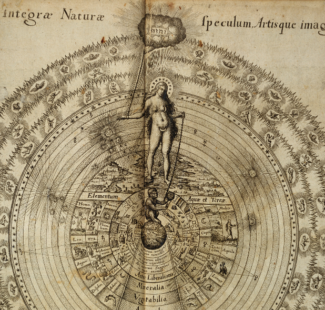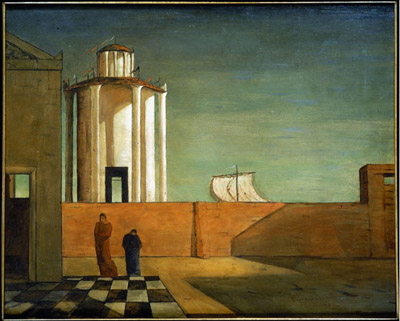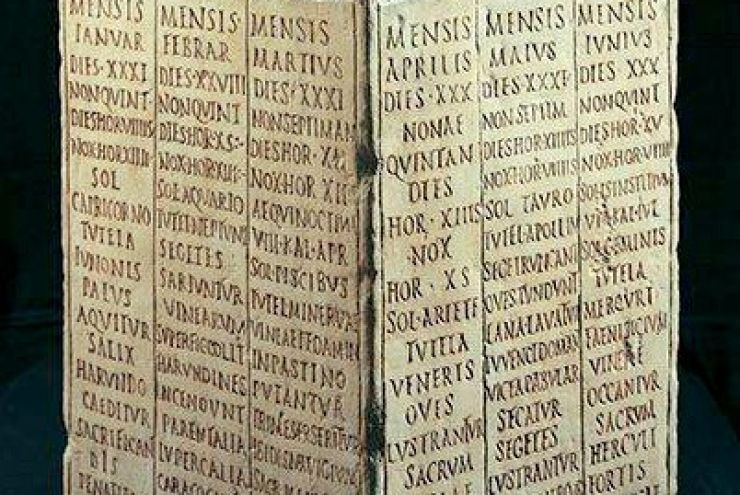 “We can understand material objects by comparison to similar objects, looking at the similarities of the surrounding things. But concerning the Good, there is no way to know it, neither by comparison with material objects nor with any perceptible thing that could resemble it. Hence, we need a different approach. Like when a person observes the sea from a panoramic viewpoint and suddenly sees the ship of a lonely fisherman, isolated, carried by waves, so in the same way we need to retreat from the perceptible world and to converse with the Good in solitude; there is no man, no living being over there, no big or small body, just a certain divine and unspeakable loneliness, simply beyond words: the Good abides there, happiness and feast, in a benevolent peace, Serene, Supreme, dwelling over the essence. But if anybody, stubbornly rooted on perceptible things, believes he can fly to the Good, and then he can live voluptuously, sure of the obtained success, well, he is completely wrong. ”
“We can understand material objects by comparison to similar objects, looking at the similarities of the surrounding things. But concerning the Good, there is no way to know it, neither by comparison with material objects nor with any perceptible thing that could resemble it. Hence, we need a different approach. Like when a person observes the sea from a panoramic viewpoint and suddenly sees the ship of a lonely fisherman, isolated, carried by waves, so in the same way we need to retreat from the perceptible world and to converse with the Good in solitude; there is no man, no living being over there, no big or small body, just a certain divine and unspeakable loneliness, simply beyond words: the Good abides there, happiness and feast, in a benevolent peace, Serene, Supreme, dwelling over the essence. But if anybody, stubbornly rooted on perceptible things, believes he can fly to the Good, and then he can live voluptuously, sure of the obtained success, well, he is completely wrong. ”
By these words, on the 2nd century CE and after a long domination of the great materialist movements, like the Epicureanism and the Stoicism, Numenius from Apamea introduces the mystic union with the Good that will be picked up by the whole Neoplatonic world, together with a new philosophical paradigm that would grant him the title of Father of Neoplatonism.
Who was Numenius? Even if John the Lydian considers him a Roman, maybe because he was teaching for some time in Rome, actually he is a Greek-speaking Syrian. In philosophy texts, he is generally presented as a Neo-Pythagorean because he used to define himself a Pythagoras’ disciple. However, he affirmed that Plato was not second to Pythagoras and reintroduced the Platonic “second navigation”. He wrote a text in favor to Plato, “About the dissent of scholars from Plato”, in which he criticized Plato’s followers because they had not understood their master’s revelations and because they drifted toward materialism. He particularly argued against Stoic philosophers and their doctrines. Numenius was not criticizing their ethic, but the poor metaphysical support due to the refusal of metaphysics.
Numenius retrieves, combines and develops concepts from Plato, Aristotle, and also from mystic-religious lines of thought of his time. The Being of Numenius is very different from the first definition by Parmenides. Numenius’ Being is transcendental thanks to the “second navigation” of Plato, who is considered the prophet of a momentous revelation, the attic Moses (as Numenius said) who offers the great revelation of the First God. The introduction of religious and redemptive aspects is fully in line with the mindset of the late ancient world, from the 2nd to the 5th century. The philosophy of that time was enriched by a religious syncretism, fed by Egyptian, Greek-Roman, Judaic, Babylonian traditions. In that time both the Chaldean Oracles and the Hermes Trismegistus were composed. Philosophy was transformed into a religion. The Neoplatonic masters were interested in the techniques to reach the ecstatic union with the Good, through the convocation of daemons or via theurgic practices. The religious aspect is central in the philosophies of Porphyry, Iamblichus, and Proclus.
Numenius, however, after having deified the Being, needed to solve the problem of the relation between a perfect, motionless, fully transcendent God, and the demiurgic work that, on the other hand, was getting his hands dirty with the material world. In other words, Numenius had to solve the mechanism of Aristotle’s Unmoved Mover to explain how it could be motionless and, at the same time, move the whole Universe. The solution proposed by Numenius is actually very similar to the Amon-Rah-Ptah Egyptian theology and to the description of the Chaldaic Oracles: God has three different functions, presented as different divinities, according to proskhrēsis (πρόσχρησις) or usage theory, that we now present.
At the top of everything there is God, who is also the Being, completely separated from the Becoming, according to Plato’s Timaeus. In fact, the Being is intelligible, while the Becoming is not. The Being is in the domain of the incorporeal, permanent, eternal, as stated by all the religions of all nations. On the contrary, the Becoming is in the domain of the corporeal, unstable and changing in time, ruled by the matter. God – Theós – is the top principle. It is convenient to talk in terms of a Triple God when focusing on his intrinsic nature, or in terms of a hierarchy of First, Second and Third God when focusing on his manifestations in the material world. God in himself is the First God, which is also the very Being and the Good.
The First God, who is intelligible as thinkable Essence, is the father, the cause of the thinking intellect, which knows the essence. Intellect, who knows the Essence, is the Second God. This function has the total vision of the ideas of its own intellective order and is associated to the Platonic Nous. It has also the demiurgic function, as the legislator that distributes souls, using the ideas to model the world.
The Third God is the universe, the meeting point between the providential psychic action of the Nous and the Necessity of the material world, also known as discursive intelligence.
God uses (proskhrēsis) his subaltern aspects, his mind or universal intellectual activity to exercise the function of Demiurge and to realize the cosmic plan by modeling the matter. Plotinus will introduce three hypostases, that exist by themselves, originating three levels of reality, while we can say that Numenius introduces only one hypostasis with three usages. Nevertheless, Numenius laid the foundation for the triad Being-Nous-Psyche of Neoplatonic philosophy.
Besides, Numenius introduces the concept of the procession that will be later used by Plotinus and then by all Neoplatonic scholars. According to this principle, the divine gives power to the lower levels without losing power. This concept is called emanation.
In this frame, matter allows the incorporation of the divine essence and the essence of the perceptible universe. Matter is disorganized and chaotic, and exist before the world because it does not have a temporal origin, as it starts its existence as a mix of Nous and Ananke (necessity). Matter tends to extend indefinitely but it is kept restrained by the intellective order of God. The Demiurge restrains it by the forms. Hence, matter is ordered by the work of the Demiurge with the Soul. The perceptible world is given by the interaction between divinity and matter and it extends from the sphere of the fixed start till to the Earth, the central and bottom place of the universe. Numenius abandons the stoic Logos by retrieving the divinity. On the other hand, he keeps two principles, matter and God, following the Platonic dualism (Monad and Dyad). Plotinus instead lets matter derive from the One, proposing in this way a complete Monism, which is the final passing from the Middle Platonism toward Neoplatonism.
From what we have written, it is possible to see that Numenius anticipated a great deal of Neoplatonic philosophy. Numenius also formulated the idea that everything is present in everything according to its essence, that is one of the central points of Plotinus’ philosophy. Gentilianus Amelius, Plotinus’ assistant, copied all Numenius’ works (sometimes in the Ancient World the only way to have a copy of a rare manuscript was to copy it by hand). Plotinus used to cite them continuously so that somebody was accusing him of plagiarizing Numenius’ philosophy. Amelius then wrote a work titled “on the doctrinal differences between Numenius and Plotinus” in order to defend his master.
Besides, according to Proclus, also Porphyry was deeply influenced by Numenius, at least for his interest toward the Chaldean Oracles. The Trinitarian scheme of Numenius was taken by Plotinus and Porphyry. The Christians, who were charged with polytheism by Jewish because of the introduction of the “Son of God” in their pantheon, took the pagan Trinitarian theory to justify the divinity of Christ. The Trinity became a dogma of the church, in other words, an obliged undiscussed doctrine, because Christians were not capable to accept a free thought. In 1600, around 1300 years after Numenius, another philosopher known as Giordano Bruno was burnt because of his heretical opinion on the Trinity. But this belongs to the dark history of Galileans, and not to the brilliant philosophic period of Polytheistic Neoplatonism, which we will write on next article about.
Mario Basile

















